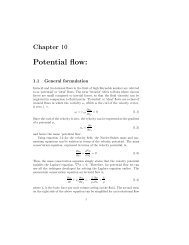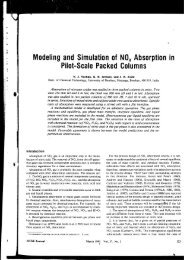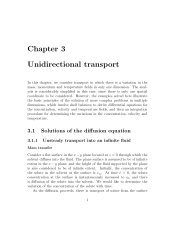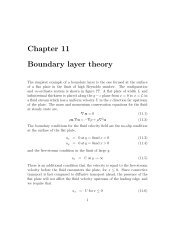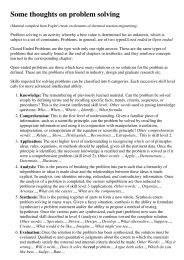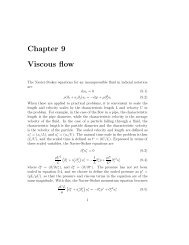Chapter 5 Steady and unsteady diffusion
Chapter 5 Steady and unsteady diffusion
Chapter 5 Steady and unsteady diffusion
You also want an ePaper? Increase the reach of your titles
YUMPU automatically turns print PDFs into web optimized ePapers that Google loves.
12 CHAPTER 5. STEADY AND UNSTEADY DIFFUSION<br />
the radius vector r = x − x 0 , <strong>and</strong> then solving equation 5.45 in a spherical<br />
coordinate system in this coordinate system. In this new coordinate system,<br />
the configuration is spherically symmetric, <strong>and</strong> so the conservation equation<br />
5.45 is<br />
K 1 ∂<br />
r ∂r r∂G = δ(r) (5.46)<br />
∂r<br />
For r ≠ 0, the right side of equation 5.46 is equal to zero, so the solution for<br />
G (upto an additive constant) is<br />
G = 1<br />
4πKr<br />
(5.47)<br />
where A is a constant to be determined from the condition at the origin.<br />
The condition at the origin is most conveniently determined by integrating<br />
equation 5.46 over a small radius ǫ around the origin,<br />
∫ ǫ<br />
−K (4πr 2 )dr<br />
(− A ) ∫<br />
= 1S(x) = dx ′ δ(x − x ′ )S(x ′ ) (5.48)<br />
r 2<br />
0<br />
The solution for the temperature field is then given by<br />
T(x) = 1 ∫<br />
4πK<br />
dx ′ S(x ′ )<br />
|x − x ′ )<br />
(5.49)<br />
Example<br />
A wire of length 2L immersed in a fluid generates heat at the rate of Q<br />
per unit length of the wire per unit time, as shown in figure 5.5. Determine<br />
the temperature field due to this wire.<br />
A cylindrical coordinate system is used, where the z axis is along the<br />
length of the wire, <strong>and</strong> the origin is at the center of the wire. The wire is<br />
considered to be a line of infinitesimal thickness in the x <strong>and</strong> y directions, so<br />
that the energy source due to the wire per unit length is given by<br />
S(x) = Qδ(x)δ(y) for − L < z < L (5.50)<br />
The temperature field, in terms of this source, is given by<br />
T(x) =<br />
=<br />
∫ ∞<br />
0<br />
∫ ∞<br />
0<br />
∫ ∞ ∫ L<br />
dx ′ dy ′ dz ′ G(x − x ′ , y − y ′ , z − z ′ )S(x ′ , y ′ , z ′ )<br />
0<br />
−L<br />
∫ ∞ ∫ L<br />
dx ′ dy ′<br />
0<br />
−L<br />
dz ′Qδ(x′ )δ(y ′ )<br />
4πK<br />
1<br />
((x − x ′ ) 2 + (y − y ′ ) 2 + (z − z ′ ) 2 ) 1/2





